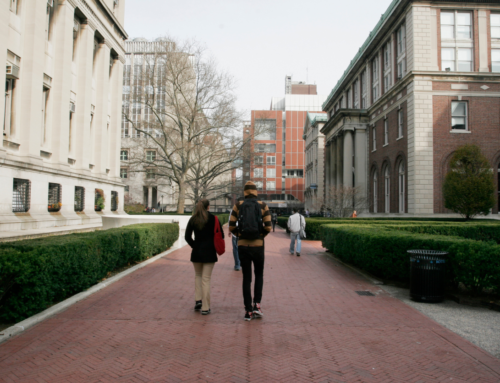High-achieving students who apply every year to the Ivies and other elites schools have heard the grim statistics about how ridiculously hard it is to get into these schools.
However, that reality doesn’t deter students from applying even though it’s pointless for most of them.
Ambitious teenagers aiming to attend the nearly impregnable schools at the top of the rankings heap tend to assume that they will surely get into one of them if they apply to enough elite institutions. They mistakenly treat the admission process as a lottery, which has lead to application inflation.
I heard from one teenager last year, for instance, who applied to more than 30 schools and he said that wasn’t unusual among his wealthy peers at a top high school in Los Angeles.
Encouraging Pointless Applications
A big culprit in this phenomenon is the schools themselves. The institutions work hard to encourage students to apply to produce their fear-inducing rejection figures.
Many elite schools strive to attract as large an applicant pool by encouraging students who have ZERO chance of getting admitted to their institutions to send in applications.
I can’t emphasize enough that if your child gets literature from an elite school, it means N-O-T-H-I-N-G. It certainly doesn’t indicate that he or she has better odds of getting into the institution.
You can’t sit down on a couch with a bag of potato chips without eating most of the bag. You hate yourself for it, but you can’t resist. And that’s how it is for elite schools that tease students for purposes of their own self-aggrandizement.
Pleasing U.S. News
This craven practice intends to burnish their images, impress families, please college presidents and boards of trustees, and, of course, curry favor with U.S. News & World kingmakers. U.S. News gives brownie points to schools that reject more students. Higher rejection rates also help a school’s bond ratings.
If you want to read a story that looks at this practice in more depth, I’d urge you to check out the following article from The Chronicle of Higher Education that appalled me when I read it a few years ago: Application Inflation.
The article focused on a cynical admission policy change at the University of Chicago that had not trouble attracting excellent applicants. Administrators, however, had decided that wasn’t good enough.
Chicago vs. Columbia
A dean said that he wasn’t satisfied because some East Coast schools were attracting more applicants. In an interview in the school’s student newspaper, the dean said the U. of Chicago deserved more applications than Columbia University because Chicago was a better school. Does anyone else find this rational galling?
The school beefed up it’s recruiting to target more students so they could reject more of them. I wonder if the dean got a bonus for breaking more hearts.
The executive who helped institute this policy, which led to the tripling of Chicago’s applicant pool since 2006, recently landed at Colby College, an elite liberal arts college in Maine. Just like U. of Chicago, Colby has never had any trouble attracting phenomenal applicants. Still, when a new college president arrived on campus, the top enrollment administrator was replaced with the Chicago numbers guy.
Here is a story that appeared in The Chronicle last week that mentions the Colby situation: The Hottest Seat on Campus.
By the way, encouraging non-competitive students to apply to institutions is hardly just a preoccupation of the most elite schools. I wrote a story about how countless schools further down the food chain do the same thing: Should You Be Flattered By a Red Carpet Treatment?
Schools Want the 10 Percenters
If elite schools were honest, they would tell applicants without a hook not to bother applying if they aren’t in the top 10% of their high school class. (I will explain what I mean by a hook shortly.) And, as a practical matter, nearly all of these 10 percenters won’t be accepted either. At a college conference that I attended last week in Indianapolis, for instance, a keynote speaker mentioned that Stanford rejects 70% of students with perfect SAT scores.
You can see for yourself how many students come from the top 10% of their high school classes by looking at each school’s stats on the College Board. When you call up a school’s profile on the College Board’s website, click on the Applying hyperlink and then the Academics and GPA hyperlink.
10 Percenter Exceptions
By the way, it doesn’t matter if a high school contains a large number of brilliant teenagers. Elite colleges and universities want the top 10%.
There are some exceptions to this 10% rule. The schools will waive the 10% rule for some legacy applicants, recruited athletes, high-achieving minorities, professors’ kids, and the children of celebrities and the super-rich.
Why 10%?
Why the obsession with the top decile?
No one would argue that children who rise to the top of their high school classes will be better students than other smart kids. The reason for the 10% rule is once again because of U.S. News & World Report. The college rankings giant gives brownie points to schools that fill their freshman classes with 10 percenters. It’s a nauseating reason, but it’s true.
10% Admission Exceptions
Many private high schools, as well as affluent public high schools, have fought back by no longer ranking. I’m sure most of these schools believe they have won this battle, but they haven’t.
Eliminating rankings hasn’t deterred colleges and universities from generating their own rankings with the information that they have for individual high schools.
You can learn more about how colleges will rank students themselves if the high schools don’t cooperate by reading the following blog post by Parke Muth, a former associate dean of admissions at the University of Virginia: Dirty Big Secrets: Part 2 Rank and Class
Summing Up:
Schools that fish almost exclusively in the 10-percent pond should tell students who aren’t in that decile that they have virtually no chance of getting in without one of the hooks as mentioned above. That, however, isn’t going to happen.
Did you enjoy the article ‘The Danger of Applying To Too Many Colleges’? If so, check out more of our articles HERE.






